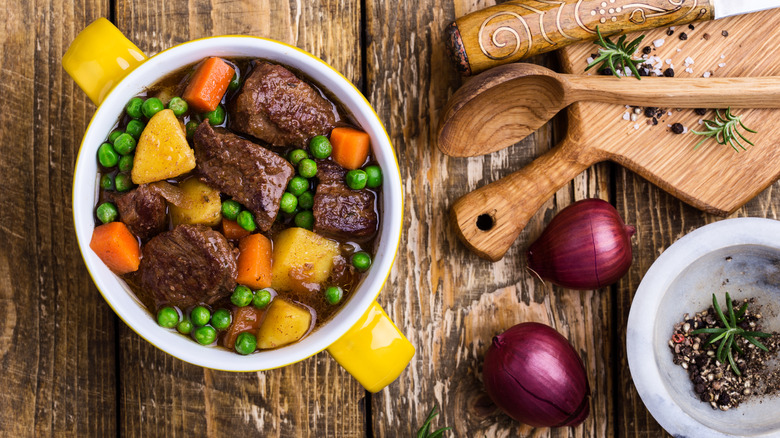What's The Difference Between Brunswick Stew And Beef Stew?
A steaming hot bowl of beef stew is comfort in its purest form, and you'll find some version of it simmering in kitchens all over the world. With recipes calling for different cuts of beef and countless variations, it's impossible to pin down a single point of origin. On the other hand, Brunswick stew, one of the classic southern comfort foods that need to make a comeback, was simmered in geographical exclusivity. Ask around, and you'll hear two strong claims for its place of birth — Brunswick County, Virginia, and the city of Brunswick, Georgia. Both have been fiercely protective of their bragging rights. To complicate matters further, some even insist the stew's story stretches back farther to Braunschweig (Brunswick) in Germany. Still, the vaunted Brunswick stew is often flaunted as distinctly American. In his book "American Cookery," legendary chef James Beard called it "one of the most famous of American dishes," per The New York Times.
Besides the difference in origins, what immediately separates a Brunswick stew from beef stew is that while beef stew is made with meaty chunks of beef, you can use a combination of meats to cook up a nice bowl of Brunswick, including beef, chicken, and pork. Certain traditional recipes also use small game like rabbit, though squirrel meat is believed to be the original ingredient of this southern recipe. These are just some of the primary differences between the two stews. There are a lot more nuanced differences that make beef stew and Brunswick stew quite different from each other.
Other key differences between Brunswick and beef stew
Brunswick stew is made in a way similar to beef stew, where the meat is slow-cooked with vegetables. The base leans heavily on tomatoes, punched up with barbecue sauce and Worcestershire sauce. The combination lends a noticeably sweeter, tangier, and smoky flavor profile to Brunswick. The supporting cast in this stew is also slightly different, except for perhaps potatoes, which are the main vegetable in both stews. You'll typically find a mix of corn, lima beans, and sometimes even bacon making their way into the pot in a Brunswick stew, along with vegetables like okra, an ingredient you'd rarely find in beef stew (for good reason, slimy okra in a beef stew is the stuff of nightmares for some).
Beef stew is relatively easier to make. It focuses on bringing out the meatier flavor of the beef and has a spicier edge. Technically, it can be made with any cut, though the best stews come from lean cuts rich in connective tissue. Using cuts like filet mignon is actually a common beef stew mistake to avoid. While there are innumerable versions of beef stew, traditional American beef stew has a generous amount of onion, ginger, and warm spices. It doesn't have the smoky-sweet tang that's a quintessential quality of Brunswick stew. Even the vegetables are meant to complement the beef, so you'll rarely find anything beyond sturdy, firm vegetables like carrots, potatoes, beans, and, at times, peas. Though different in many ways, the one common thread between the two stews is that they're both hearty, warming bowls of pure joy.

